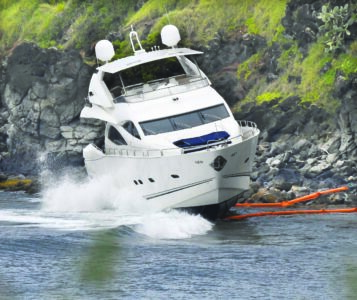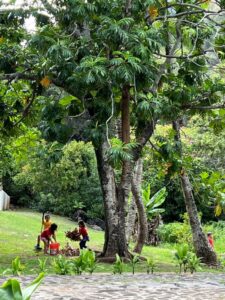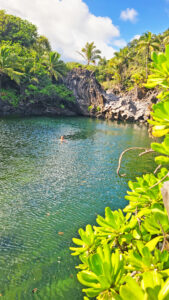Board fines trust $117,000 over grounded yacht incident
Penalties for vessel operator to be decided by state at a later date
A trust affiliated with the luxury yacht that was grounded for two weeks on the West Maui shoreline will pay a fine of around $117,000 for the damages and costs to the state under a settlement agreement approved Friday by the state Board of Land and Natural Resources.
Kevin and Kimberly Albert, trustees of the Albert Revocable Trust in New Mexico, will pay the state a recommended a penalty of $117,471.97, which was calculated by the state Department of Land and Natural Resources’ Division of Aquatic Resources.
DAR officials said at Friday’s board meeting that the total was based on the biological damage — which included damage to 119 stony coral colony specimens and 1,640.5 square meters of live rock — along with violations and staff costs.
But penalties for Jim Jones of Noelani Yacht Charters, who bought the 94-foot luxury yacht “Nakoa” from the trust and had been on the vessel when it grounded, will be determined later.
“We primarily want more community input such as cultural impact from the Nakoa grounding incident,” said Board Member Doreen Canto of Maui, who made the motion to accept the settlement agreement and defer action for Jones and Noelani Yacht Charters.
Board Member Wesley “Kaiwi” Yoon said that “the board is still contemplating and open to seeking any kind of fair and reasonable damages done to our cultural and natural resources.”
He said he wanted to be clear to the community and those who hold Honolula Bay as very special that “it’s not over.”
“Just because we are settling here because it is fair and reasonable based on our metrics and in-house metrics as to what kind of damage this is, and what that might cost to the coral might be,” he said. “I personally struggle with the fact that there is no abacus or calculator to either begin to quantify how much adverse affect the cultural resources might cost. I’m hopeful with this board and this administration that we can soon take those steps to contemplate that.”
Canto, Yoon and other board members initially felt the recommended fines for all the parties, which included the trust and Jones, was too low.
“I just don’t agree with it all.
It does an injustice to our department,” Canto said prior to an executive session to discuss the possible settlement.
BLNR Chairwoman Dawn Chang said she understood board members’ concerns but noted that the settlement agreement does not preclude the board from seeking damages from Jones.
Chang also said that the Albert trust insurance repaid the state for the approximately $470,000 in towing costs and that the trust has cooperated with the state.
The settlement agreement also releases the Alberts and the trust from any future claims related to the incidents.
Charlie Taylor, a legal fellow with the Division of Aquatic Resources, explained the breakdown for the fines — $60,220 for the resource value that was damaged, $56,851.97 in administrative costs relating to the incident and $400 for other violations.
Taylor said that DAR uses its own matrix in deriving penalties for damaging stony coral and live rock, in which marine life is visibly attached or affixed. He said the matrix is used because damages to coral or live rock may not be all the same, and there is also differing values to corals.
State law does allow for a fine of $1,000 per coral specimen injured along with $1,000 per live rock specimen injured.
The maximum administrative fine for the 119 stony coral colony specimens damaged would be $120,000, which includes a $1,000 administrative fine for a first-time stony coral damage violation. The maximum administrative fine for the 1,640.5 square meters of live rock damage would be $1.642 million, which would also include the $1,000 administrative fine for the first-time live rock damage, Taylor said.
“This tool and what we are doing, we are investigating the biological impact to the area. We are focusing on living coral and on live rock habitat,” said Russell Sparks, state aquatic biologist on Maui, in response to a board member’s question regarding the fine recommendation.
“I know a lot of people were upset, it was a big boat, it was very visible, it was very upsetting,” Sparks said. “We don’t have a way from a biologist point of view of integrating that into this. That’s more your role I guess in the fines. But from a biological perspective, this is what we found.”
The yacht grounded along the rocky shoreline in late February, setting off a two-week struggle to remove it and spurring public criticism from residents and environmental advocates.
Jones was on the Nakoa with family, friends and a crew and had moored the 120-ton yacht overnight in Honolua Bay from Feb. 18 to 19, according to DAR.
Between 5:20 and 5:45 a.m. on Feb. 20, the Nakoa became adrift and grounded onto the shoreline. Eight boaters on board were rescued by the Maui Fire Department. Officials tried to remove the yacht the same day during high tide but were unsuccessful. The next day, Maui DAR staff conducted the first biological site assessment.
State officials said the grounding was outside the Honolua-Mokuleia Bay Marine Life Conservation District.
After the U.S. Coast Guard “federalized” the vessel, allowing for the removal of batteries, fuel and other potentially hazardous materials, DLNR and a salvage team worked to move the yacht from the shoreline. Some attempts failed due to poor weather and failed rigging.
But on March 5, the team was able to move the Nakoa into deeper water, and as they towed it out to sea, it sank in about 800 feet of water.
Maui DAR staff conducted a second biological site assessment of the damages on March 7.
Community members during the meeting on Friday asked the board to levy the maximum penalties possible.
Paele Kiakona, who is acting president of the Save Honolua Coalition and said he was one of the first that responded to the grounding, understood the damage assessment for the coral and live rock but questioned the potential damage that leaking diesel has caused. DLNR officials said shortly after the grounding that diesel fuel was leaking from the boat’s hull and that booms had been placed to keep it from moving out of the area.
Kiakona advocated for the maximum fine, noting also the “emotional damage that is has done to the community” and to “people like myself that utilize this area and care very deeply about this place.”
“This will send a strong message to communities across Hawaii to show that our state is advocating for the right thing. And I believe this is the right thing to do,” Kiakona said.
Kai Nishiki, an environmental and shoreline access advocate, also asked for the maximum fine.
“This is really about setting a precedent and sending a real message about how important our public trust resources are and protection of them,” Nishiki said.
Napili resident Leonard “Junya” Nakoa, who also pushed for a maximum fine, said he goes to the area once or twice a week, while some go there every day.
“We got to deal with these dummies that come over there and disrespect our cultural rights and our resources and everything about Honolua and what it means to us,” Nakoa said.
He added that while the yacht was grounded, he and other community members couldn’t go to the site as they normally do.
In March, the Albert Revocable Trust filed a lawsuit in federal court against Jones and his company, Noelani Yacht Charters, seeking more than $2 million in damages.
The lawsuit said Jones and the company purchased the yacht for $1.45 million in December and used the commercial vessel “in a grossly negligent manner” for a personal trip without seeking the approval of the trust. The suit also was filed against the captain.
The Alberts are seeking at least $1.45 million for the loss of the yacht, which was supposed to be paid off over the course of 15 years, as well as at least $500,000 for the salvage work and at least $500,000 for environmental damages, according to the suit filed in March.
* Staff Writer Melissa Tanji can be reached at mtanji@mauinews.com.
- The 94-foot luxury yacht Nakoa is seen grounded along the rocky shoreline in the Honolua Bay area on Feb. 24. — The Maui News / MATTHEW THAYER photo
- A damaged coral is shown during an assessment by the state Department of Land and Natural Resources’ Division of Aquatic Resources at Honolua Bay on March 7. — Photo courtesy DLNR







